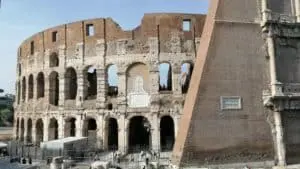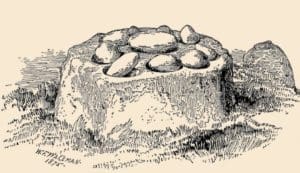The Dark Knight’s Gotham: Unveiling the Chicago Behind Batman’s City

Updated On: April 04, 2024 by Maha Yassin
Gotham City, the iconic urban landscape immortalised as Batman’s hunting ground, was masterfully brought to life in Christopher Nolan’s The Dark Knight. Far from a mere backdrop, Gotham is a pulsating character in its own right, its towering spires and shadowy alleys pulsing with the lifeblood of Nolan’s vision. Under this visionary director’s guidance, Chicago was transformed into the brooding metropolis of Gotham, adding authenticity to the Caped Crusader’s world and showcasing the Windy City’s architectural magnificence.
The selection of Chicago as the stand-in for Gotham was far from arbitrary; its steel-and-glass canyons and gritty underbelly mirrored Batman’s dual nature as a vigilante and hero, blurring the lines between fiction and reality. The city’s notable landmarks doubled as pivotal settings within the film, giving audiences a tangible connection to the world of Gotham. This intertwining of two identities—Chicago’s urban reality and Gotham’s fictional veneer—crafts a cinematic language that speaks to the die-hard fans of the Batman legacy and lovers of great filmmaking.
Exploring The Dark Knight’s Chicago is to walk through a narrative of powerful themes, from the depths of vigilantism to the heights of sacrifice. Nolan’s trilogy delves deep into the symbolism of Batman, transcending the superhero genre and pondering questions of morality, law, and humanity. It’s through these streets and atop these skyscrapers that the Dark Knight’s story unfolds—an homage not just to a comic book legend but to the enduring allure of cinema and storytelling.
Origins and Evolution of the Batman Legacy
In this dedicated look at The Dark Knight’s heritage, we delve into the creative sparks that ignited the Batman phenomenon and tracked its growth through various media over the years.
Bob Kane’s Vision and Neal Adams’ Contributions
Bob Kane, alongside writer Bill Finger, conceived Batman in 1939, a character who rapidly became a cornerstone of comic lore. He was envisaged as a dark and brooding hero, a stark contrast to the bright and optimistic superheroes of the time. Batman’s initial appearance in ‘Detective Comics #27’ marked the beginning of a legacy that would extend far beyond the pages of the comics.
Neal Adams, who began working on Batman in the late 1960s, brought a new level of dynamism and realism to the artwork. His tenure is particularly noted for reviving the character’s dark roots and expanding the story’s emotional range. Adams’ efforts helped transform Batman into a character with complex psychological depth, reverberating through Gotham’s panels in a way that would heavily influence future depictions.
The Transition to Silver Screen Adaptations
As Batman’s presence in comics solidified, the character leapt to the silver screen, with each adaptation echoing the evolving perceptions of Gotham’s vigilante. Tim Burton’s films in the late 1980s and early 1990s reintroduced audiences to Batman’s gothic elements, often highlighted by a brooding atmosphere and darker storytelling.
Subsequently, Joel Schumacher took the helm, offering a different interpretation in the mid-1990s that veered towards a lighter, more colourful aesthetic. However, Christopher Nolan’s Dark Knight Trilogy radically reshaped the cinematic portrait of Batman, integrating a realistic and gritty take on the hero and his world. This extreme depth bridged the divide between comic books and cinema, bringing the essence of Gotham to life with unprecedented authenticity.
Christopher Nolan’s Vision for Gotham

In crafting The Dark Knight, Christopher Nolan established a version of Gotham that was both fantastical and familiar—a city that could exist in our very world.
Realism and Grit in The Dark Knight
Nolan’s Gotham isn’t a distant, gothic nightmare; it’s an actual city pulsing with life and grime. The decision to shoot in Chicago infuses the film with an urban authenticity that fans recognise and appreciate. Skyscrapers tower over the streets where Batman’s battle for justice unfolds, their steel and glass silhouettes painting a skyline that belongs to a modern metropolis, not a comic book exaggeration.
The city’s underbelly, revealed through the corruption in its institutions, is reminiscent of Gotham’s gothic roots, yet it’s portrayed with a gritty realism. Nolan’s choice to use practical effects over CGI enhances the believability of Batman’s world, where the action feels tangible and the danger immediate.
Balancing Darkness and Light
In The Dark Knight, Nolan expertly balances the light against the shadows. Gotham is a character in its own right, showcasing the duality of Batman’s persona. By day, the city is a mosaic of humanity hustling and surviving; by night, it becomes a canvas for the Caped Crusader’s war against crime. Yet, Nolan ensures that even in the darkest night, light prevails through the resilient hope of its citizens and the moral struggle of its heroes, notably District Attorney Harvey Dent.
Throughout the film, the interplay of light and dark is unmissable, a visual metaphor for the overarching theme: the struggle between good and evil. Nolan doesn’t shy away from complex narratives where darkness can consume heroes just as readily as villains, questioning whether Gotham can truly be saved or if it is forever doomed to dance on the knife edge of chaos.
Gotham as Chicago: The Urban Influence

In the creation of Gotham for The Dark Knight, Chicago’s visceral and architectural essence was harnessed to ground the fictional city in a tangible reality. Chicago’s distinctive skyline and urban fabric are skillfully woven into the narrative, showcasing how a real city can become a character within the film world.
Chicago’s Architecture
Chicago’s architecture plays a pivotal role in characterising Gotham City. Landmarks like the Chicago Board of Trade are a focal point for Gotham’s skyline, emulating the grandeur and formidable nature of a city plagued with crime and heroism. The city’s skyscrapers, with their imposing steel and glass structures, mirror Gotham’s struggle between light and dark, reflecting the complexities of Batman’s duality.
The Role of the Chicago Film Office
The cooperation with the Chicago Film Office, under the stewardship of Rich Moskal, was instrumental in facilitating the filming process, bridging the gap between the fictional Gotham and real-world Chicago. Thanks to their support, extensive film shoots were successfully conducted in key locations throughout the city, bringing the authenticity that director Christopher Nolan envisaged to the big screen.
Iconic Locations and Their Real-World Counterparts

In ‘The Dark Knight‘, Gotham City’s imposing skyline and gritty streets are brought to life through various Chicago landmarks. We explore these locations and unveil the real-world buildings that stood in for some of the most recognisable settings in Gotham.
Wayne Tower and the Chicago Board of Trade
Wayne Tower, the fictional headquarters of Bruce Wayne’s business empire in ‘The Dark Knight’, finds its real-life counterpart in the Chicago Board of Trade Building. A leading icon featured prominently in the film, the Chicago Board of Trade’s art deco architecture perfectly encapsulates the majestic aura of Wayne Enterprises, towering over Gotham City’s financial district just as it does in Chicago’s Loop.
The Dark Knight’s Chicago Landmarks
Within the urban canvas of Chicago, several other sites doubled as key locations in Gotham City. Lower Wacker Drive was transformed into a high-speed chase scene, revealing the dark underbelly of Gotham only comparable to Lower Wacker’s unique multi-level street system. The formidable Richard J. Daley Center was the courtroom for many of Gotham’s high-stakes trials, mirroring its actual use in the heart of Chicago’s legal landscape. These landmarks grounded the superhero epic in a tangible reality and elevated Chicago’s status as a versatile cinematic city that effortlessly embodies the essence of Gotham.
The Dark Knight’s Cinematography and Sound
In “The Dark Knight“, the visual storytelling and auditory experience are paramount, with Hans Zimmer’s compositions enhancing the intense narrative. At the same time, CGI and practical effects create a seamless reality in Gotham’s cityscape.
Hans Zimmer’s Musical Storytelling
Hans Zimmer’s score for “The Dark Knight” is a sonic exploration of the film’s complex themes. His compositions weave a compelling auditory narrative that mirrors the on-screen action. Zimmer uses a combination of electronic music and traditional orchestral elements to underscore the vigilante’s struggle against chaos. The Joker’s theme, for instance, is distinguished by a single, unsettling two-note motif, which encapsulates the character’s unruly presence.
The Use of CGI and Practical Effects
“The Dark Knight” is lauded for its judicious use of CGI, enhanced by an array of practical effects to ground the story in a tangible reality. The fusion of these techniques is exemplified in the film’s chase sequences and the demolition of the Gotham General Hospital. Instead of relying solely on digital imagery, director Christopher Nolan favoured practical methods, such as employing miniature models and controlled explosions, which were then augmented with CGI for detail and scope. This approach not only lent authenticity to the action but also maintained the visual continuity throughout the film.
Casting The Dark Knight’s Iconic Characters

Selecting the perfect actors to bring The Dark Knight’s pivotal characters to life was crucial for the film’s authenticity and impact. This section explores the casting choices for Bruce Wayne and the Joker, roles immortalised by talented actors who brought depth and complexity to Gotham’s hero and his arch-nemesis.
Christian Bale as Bruce Wayne
Christian Bale took on the mantle of Bruce Wayne, a role that demanded both the suave demeanour of Gotham’s elite billionaire and the intense physicality of Batman. Bale’s performance was lauded for his transformation from the charming playboy to the brooding caped crusader, with his portrayal becoming a defining one for the character.
The Joker’s Various Personifications
Similarly, the Joker has been personified by various accomplished actors, including Jack Nicholson and, more recently, in The Dark Knight, by Heath Ledger. Ledger’s Joker was a chaotic blend of frenetic energy and chilling psychosis, earning him a posthumous Oscar for Best Supporting Actor. His portrayal was strikingly different from Nicholson’s but equally iconic in the annals of comic book cinema.
The Symbolism of Batman in Modern Culture
Batman transcends the pages of comic books to become a pervasive symbol in pop culture, embodying complex themes that resonate deeply within modern society.
Batman as a Cultural Icon
We recognise Batman, also known as Bruce Wayne, as more than just a superhero; he is a cultural icon reflecting complex aspects of the human condition. His dual identity as the tormented billionaire and the caped crusader represents a powerful symbol of justice and vigilantism in pop culture. This duality captures our fascination with the fine line between order and chaos, a recurrent theme in the urban landscape of Gotham—equally symbolised by cities like Chicago, as seen in The Dark Knight. Batman’s portrayal varies from a brooding detective to a beacon of hope, signalling society’s changing perceptions of heroism.
Public Reception and the Superhero Phenomenon
Batman’s public reception underscores the superhero phenomenon’s grip on our imagination. He’s embraced worldwide not just through comics and films but as an emblem of the perpetual struggle against adversity. Though superheroes are fictional, they offer real-life inspiration, with Batman, in particular, embodying resilience and resourcefulness, qualities that earn him a revered place in pop culture. The influence of Batman is so significant that it extends beyond entertainment, inspiring dialogue on themes of morality, heroism, and the individual’s role in society.
Exploring the Themes in Nolan’s Trilogy

Christopher Nolan’s Batman films are remarkable for exploring profound and complex themes, particularly fear, trauma, vengeance, justice, and corruption, all set against the urban backdrop of Gotham—remarkably portrayed by the city of Chicago.
Fear, Trauma and Vengeance
At the outset of Nolan’s trilogy, fear is a foundational theme—a weapon against the weak and a crucible for the strong. Bruce Wayne’s trauma, stemming from the murder of his parents, fuels his transformation into Batman. His journey to overcome this fear mirrors the arc of Gotham itself, a city riddled with crime and a pervasive sense of dread. Through training with the League of Shadows, Bruce confronts his demons, leading him to don the guise of what he fears: a bat. This symbolism is a linchpin of the trilogy, notably in “The Themes And Meanings Of THE DARK KNIGHT Trilogy“.
Batman’s crusade against the criminal underworld is driven by vengeance, yet it’s clear that it’s also a quest for a sense of justice and catharsis—not only for himself but for Gotham. Overcome by trauma, characters like Bruce Wayne and even the villainous Scarecrow illustrate how individuals process fear, leading to heroic resolve or a descent into madness.
Corruption and the Quest for Justice
Corruption is depicted as a cancer that has infiltrated the institutions designed to protect Gotham. In “The Dark Knight,” the corruption of the city’s officials and police force births chaos—a chaos the Joker exploits to devastating effect. He challenges Batman’s mission for justice, proving that the line between order and anarchy is perilously thin.
In his quest for justice, Batman faces moral difficulties that test the limits of his code. The drive to eradicate corruption places him against the system he aims to save. It’s a battle that brings Bruce Wayne face to face with the ethical boundaries of vigilante justice. As highlighted in the exploration of “What Each Dark Knight Trilogy Movie Represents,” this theme matures throughout the films, presenting justice not as a clear-cut goal but as a complex landscape where the shadow of the Dark Knight obscures the lines between right and wrong.
The Art of Adaptation: From Comics to Film

This section explores the meticulous process of transforming the iconic Batman comics into a cinematic experience. This includes honouring the original materials and overcoming the unique challenges of film adaptation.
Respecting the Source Material
When we adapt a comic book into a film, we must respect the original material that has engaged fans for decades. Filmmakers must strike a delicate balance: preserving the essence of the comics while crafting a movie that stands on its own merits. For example, the Batman comics that inspired Christopher Nolan’s The Dark Knight provided a deep well of inspiration.
The Challenges of Bringing Comics to Life
Adapting comics to the big screen presents its own set of challenges. Filmmakers must navigate the comic book medium’s complex visual and narrative structures while delivering a film accessible to seasoned fans and new audiences. The heightened realism of a film demands a careful reimagining of Gotham, a task that requires meticulous attention to detail and a deep understanding of the source medium’s appeal.
Impact and Legacy of The Dark Knight Trilogy
We examine the enduring influence of Christopher Nolan’s The Dark Knight Trilogy and how it reshaped the superhero film genre while paving the way for the future of the Batman franchise.
Influence on Modern Cinema
The Dark Knight Trilogy, particularly The Dark Knight, is a touchstone in modern cinema that redefined what a superhero film could be. Influencing countless filmmakers, this trilogy moved away from the light-hearted portrayals of the genre, offering a darker, more complex narrative that was both critically acclaimed and commercially successful. The realism and moral ambiguity set by Batman Begins fundamentally shifted audience expectations of character development and storytelling in superhero movies.
The impact of Nolan’s work transcended the Batman narrative, inspiring Warner Bros. to adopt a similar gritty tone for other DC Comics adaptations. Nolan’s approach influenced the industry as studios emphasised character-driven stories and the psychological depth of their heroes and villains.
The Future of the Batman Franchise
Following The Dark Knight Trilogy, Warner Bros. continued to evolve the portrayal of Batman. With the release of The Batman, directed by Matt Reeves, audiences were introduced to a fresh take on the Dark Knight that builds on the foundation laid by Nolan. Reeves’ adaptation presents a younger Batman, portraying his detective roots and continuing the move towards realism.
The legacy of The Dark Knight Trilogy is clear, as it not only set a new standard for character development within the genre but also for producing a culturally significant and sophisticated narrative. The trilogy’s nuanced portrayal of heroism and villainy remains a benchmark for the franchise and superhero cinema.

FAQs
Our exploration of The Dark Knight’s filming locations reveals the fusion of Gotham City with the real-world tapestry of Chicago’s skyline, streets and architecture.
Which Chicago locations were used in the filming of The Dark Knight?
Among the multiple Chicago locations, Lower Wacker Drive, the Old Post Office, and the Chicago Board of Trade Building were backdrops for Gotham City’s intense action sequences and dramatic moments. These sites exemplify the city’s gritty and imposing character in the film.
How can one identify Gotham City’s inspiration in Chicago’s architecture?
The towering skyscrapers and neo-Gothic structures of Chicago mirror Gotham’s aesthetic in the film. Notably, the dark tones and the sharp angles of buildings like the Willis Tower capture Gotham’s brooding atmosphere.
What are the differences between the filming locations of Batman Begins and The Dark Knight?
While both films used Chicago as a primary location, The Dark Knight expanded its canvas to include more recognisable sites like LaSalle Street, which contrasted against the more soundstage-centric and fantastical version of Gotham in Batman Begins.
Are any organised tours focusing on The Dark Knight’s filming spots in Chicago?
To our knowledge, specialised tours guide Batman enthusiasts through the city’s streets, highlighting key locations from The Dark Knight. These tours offer fans a chance to walk in the footsteps of the Caped Crusader.
What reasons were behind the decision not to film The Dark Knight Rises in Chicago?
The Dark Knight Rises aimed to portray a different facet of Gotham. Thus, the production shifted to other cities like Pittsburgh and New York to offer a fresh perspective and setting that matched the narrative progression of the trilogy.
Can you provide details on the tunnel scene in The Dark Knight and where it was filmed?
The iconic tunnel scene, known for its high-speed chase, was filmed in Lower Wacker Drive, a location praised for its lower street level providing a shadowy, enclosed atmosphere that heightened the movie’s tension.






